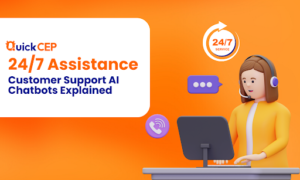What Is Conversational AI?
How Does Conversational AI Work?
What Are The Benefits Of Conversational AI?
1. Improved Customer Experience
Since conversational AI can mimic human conversations, it can provide an improved and personalized customer experience. For example, a conversational AI can give tailored-fit product suggestions according to customers’ needs and interests.
2. Increased Efficiency and Cost Savings
Handling hundreds of support tickets overnight is costly if you rely on human agents. AI chatbots can simultaneously handle these tickets around the clock at a lower cost. No need to hire additional staff that incurs wage and benefit expenses. Customer-to-agent conversations can be tedious, repetitive, and time-consuming, distracting your staff from performing other essential tasks. You can deflect basic customer inquiries and save time by using chatbots.3. Data-Driven Decision-Making
All conversations between the chatbot and your customers become insightful data points. For example, conversational AI can record your monthly conversation rates and leads generated to track your business performance. Data collected and analyzed by AI can help guide your next marketing or sales strategies.4. Expanded Reach and Accessibility
Using conversational AI is effective in scaling your customer service without adding human agents. A chatbot can automatically handle a new influx of customer traffic to your website or application. More impressively, your chatbot can also serve your international clients in any time zone.5. Innovation and Competitive Advantage
Adopting AI in customer service will give you an edge against competitors who are not yet leveraging this technology. You’ll stand out as an innovative firm providing convenient and accessible solutions to customers.Different Types of Conversational AI Technologies
There are various types of conversational AI solutions with different features and functionalities. Let’s discuss them in detail below.
Chatbots
Chatbots can interact with a user in human languages. Using training sources like knowledge bases, documents, and articles, chatbots can respond to basic text inputs provided to them.
Consider QuickCEP’s AI chatbots. By training them using your business’s knowledge base or help documents, it can automatically respond to customers’ inquiries and concerns.

Virtual AI Assistants
Virtual AI assistants are software programs designed to understand text or voice commands. Usually, these assistants follow the instructions provided to them. Amazon Alexa, Microsoft Cortana, and Apple Siri are some of the popular virtual AI assistants. They can perform tasks instructed to them like scheduling appointments, transcribing calls, and recording information.Interactive Voice Assistants (IVAs)
IVAs are a special type of virtual AI assistant that responds to voice prompts. This AI-powered technology captures the voice prompt and breaks it down into structured data using natural language processing. Afterward, the assistant provides a voice response to the user. For example, a customer can tell the IVA about his delayed package. The IVA will understand the voice input and provide a voice output for the customer.Voice bots
As with IVAs, voice bots also understand voice inputs and engage in verbal communication. However, their predefined voice script or response constraints voice bots’ responses. Hence, it lacks the flexibility to answer inquiries beyond its programmed rules.Machine Translators
Machine translators use artificial intelligence to translate text from one language to another. These translators are more powerful than the “traditional” ones because they also consider language nuances and contexts to provide an accurate translation. Google Translate is a prominent example of this technology. This translator provides high-quality translations by considering the language’s grammar rules, syntax, structure, and usage.how to Integrate Conversational AI in your Business

QuickCEP lets you develop a conversational AI chatbot on your e-commerce website with no coding required. The process is super easy. Upon account creation, go to your dashboard and click “Bots”. Afterward, upload training sources like spreadsheets, documents, and PDFs. You can also link your web pages as a chatbot training resource.
Click Start Training to let QuickCEP develop your conversational AI chatbot.
That’s it! You now have a conversational AI ready to address your customer inquiries. You can use QuickCEP’s Playground feature (in the dashboard) to test your chatbot before deployment.



